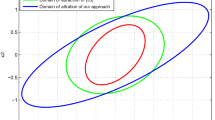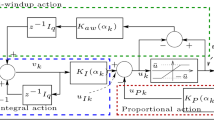Abstract
An anti-windup controller for multi-input nonlinear system is proposed in this paper. The proposed method does not need to calculate every time for every fuzzy rules comparing with traditional linear pole placement of T-S(Takagi-Sugeno) fuzzy. This means fewer LMIs(linear matrix inequality) will be needed and its solution will be guaranteed as much as possible. For different saturation limit, different D-stable disk center and radius of pole placement can be selected to eliminate input saturation effect directly. Nonlinear system will be transferred to T-S fuzzy model first. Then, by employing a series of transition matrix, nonlinear system will be transferred into a nearly linear format accompanied by a nonlinear part. Finally, by designing a proper controller, linear pole placement method can be used and the controller gains can be calculated out with LMIs.
Similar content being viewed by others
References
T. Takagi and M. Sugeno, “Fuzzy identification of systems and its applications to modeling and control,” IEEE Transactions on Systems, Man and Cybernetics, vol. 15, no. 1, pp. 116–132, 1985.
H. Wang, K. Tanaka, and M. Griffin, “Parallel distributed compensation of nonlinear systems by Takagi-Sugeno fuzzy model,” Proc. FUZZ-IEEE/IFES, pp. 531–538, March 1995.
J. Jang, S. Kwon, and E. Jeumg, “Asymptotic and robust stability of T-S fuzzy genetic regulatory networks with time-varying delays,” International Journal of Robust and Nonlinear Control, vol. 22, no. 8, pp. 827–840, 2012. [click]
M. Sugeno and G. T. Kang, “Fuzzy modeling and control of multilayer incinerator,” Fuzzy Sets Syst., vol. 18, no. 3, pp. 329–346, 1986.
E. T. Jeung and K. R. Lee, “Static output feedback control for continuous-time T-S fuzzy systems: an LMI approach,” International Journal of Control Automation and Systems, vol. 12, no. 3, pp. 703–708, Jun. 2014. [click]
S.P. He, “Fault estimation for T-S fuzzy Markovian jumping systems based on the adaptive observer,” International Journal of Control Automation and Systems, vol. 12, no. 5, pp. 977–985, Oct. 2014. [click]
S. Idrissi, E. Tissir, I. Boumhidi, and N. Chaibi, “New delay dependent robust stability criteria for T-S fuzzy systems with constant delay,” International Journal of Control Automation and Systems, vol. 11, no. 5, pp. 885–892, Oct. 2013. [click]
Z. Zhang, C. Lin, and B. Chen, “New stability and stabilization conditions for T-S fuzzy systems with time delay,” Fuzzy Set and Systems, vol. 263, pp. 82–91, Mar. 2015. [click]
A. Isidori, Nonlinear Control Systems, 3rd ed., Springer-Verlag, London, 1995.
J. Belikov, U. Kotta, M. Tonso, and Z. Bartosiewicz, “Dynamic feedback linearization of nonlinear control systems on homogenous time scale,” Proc. of IEEE Conference on Control Applications, pp. 947–952, Oct. 2014.
K. Sajjadi and F. Jabbari, “Controllers for linear systems with bounded actuators: Slab scheduling and anti-windup,” Automatica, vol. 49, no. 3, pp. 762–769, Mar. 2013. [click]
P. Buckley, “Designing override and feedforward controls,” Control Engineering, vol. 18, no. 8, pp. 48–51, 1971.
R. Hanus, M. Kinnaert, and W. Luyben, “Conditioning technique, a general anti-windup and bumpless transfer method,” Automatica, vol. 23, no. 6, pp. 729–739, 1987. [click]
K. Navneet and D. Prodromos, “Observer-based antiwindup scheme for non-linear systems with input constraints,” International Journal of Control, vol. 72, no. 1, pp. 18–29, 1999. [click]
A. Zheng, M. Kothare, and M. Morari, “Anti-windup design for internal model control,” International Journal of Control, vol. 60, no. 5, pp. 1015–1024, 1994. [click]
W. Levine, The Control Handbook, CRC Press, FL, USA, 1996.
L. Zaccarian, Y. Li, E. Weyer, M. Cantoni, and A. Teel, “Anti-windup for marginally stable plants and its application to open water channel control systems,” Control Engineering Practice, vol. 15, no. 2, pp. 261–272, 2007. [click]
G. Herrmann, P. Menon, and M. Turner, “Anti-windup synthesis for nonlinear dynamic inversion control schemes,” International Journal of Robust and Nonlinear Control, vol. 20, no. 13, pp. 1465–1482, 2010. [click]
Y. K. Ma and H. B. Ji, “Robust control for spacecraft rendezvous with disturbances and input saturation,” International Journal of Control Automation and Systems, vol. 13, no. 2, pp.353–360, Apr. 2015.
H. Chen, “Robust stabilization for a class of dynamic feedback uncertain nonholonomic mobile robots with input saturation,” International Journal of Control Automation and Systems, vol. 12, no. 6, pp. 1216–1224, Dec. 2014.
W. Chang, H. Liang, and C. Ku, “Fuzzy controller design subject to actuator saturation for dynamic ship positioning systems with multiplicative noises,” Proc. IMechE 2010, pp.725–736, April 2010.
W. Chang, C. Ku, and H. Liang, “Actuator saturation constrained fuzzy control for discrete stochastic fuzzy systems with multiplicative noises,” Mathematical Problems in Engineering, vol. 2013, pp.1–9, 2013.
T. Hu, Z. Lina, and B. Chenb, “Analysis and design for discrete-time linear systems subject to actuator saturation,” Systems & Control Letters, vol. 45, no. 2, pp. 97–112, 2002. [click]
T. Hu, A. Teel, and L. Zaccarian, “Stability and performance for saturated systems via quadratic and nonquadratic Lyapunov functions,” IEEE Trans. Automat. Contr., vol. 51, no. 11, pp. 1770–1786, 2006. [click]
W. Chang and Y. Shih, “Fuzzy control of multiplicative noised nonlinear systems subject to actuator saturation and performance constraints,” Neurocomputing, vol. 148, pp. 512–520, 2015.
S. Wen and Y. Yan, “Robust adaptive fuzzy control for a class of uncertain MIMO nonlinear systems with input saturation,” Mathematical Problems in Engineering, vol. 2015, pp. 1–14, 2015.
M. Chilali and P. Gahinet, “Design with pole placement constraints: an LMI approach,” IEEE Transactions on Automatic Control, vol. 41, no. 3, pp. 358–367, 1996.
F. Wang, S. Park, T. Yoon, and G. Kwak, “Linearization of discrete-time T-S fuzzy model with multiple input,” Proceedings of the International Conference on Intelligent Systems Design and Applications, pp. 1321–1324, 29 Nov 2010.
T. Yoon, F. Wang, S. Park, G. Kwak, and H. Ahn, “Linearization of T-S fuzzy systems and robust H-infinity control,” Journal of Central South University of Technology, vol. 18, no. 1, pp. 140–145, 2011. [click]
U. Nasir and R. Azizur, “High-speed control of IPMSM drives using improved fuzzy logic algorithms,” IEEE Transactions on Industrial Electronics, vol. 54, no. 1, pp. 190–199, 2007.
A. Cherifi, K. Guelton, and L. Arcese, “LMI conditions for non-quadratic stabilization of T-S models with pole placement assignation control,” Proc. of International Conference on Engineering & Information Technology, pp.1–6, 2015.
Y. Luo, Q. Wu, and A. Jiang, “Anti-windup compensator design for fuzzy descriptor system with delayed state and saturating input,” Proceedings of 26th Chinese Control and Decision Conference, pp.1656–1659, June 2014.
Author information
Authors and Affiliations
Corresponding author
Additional information
Recommended by Associate Editor Jun Yoneyama under the direction of Editor Euntai Kim. This work was supported in part by the Fundamental Research Funds for the Central Universities (2013QNB26) and the Project Sponsored by the Scientific Research Foundation for the Returned Overseas Chinese Scholars, State Education Ministry(2013-47).
Fa-Guang Wang received his B.S. degree in Automation Control Engineering from Huazhong University of Science and Technology, China, in 2006 and his Ph.D. degree in Electrical Engineering from Changwon National University, Korea, in 2011. Since 2012, he has been with the School of Information and Electrical Engineering, China University of Mining and Technology. His research interests include nonlinear control, intelligent control, optimal control and system identification.
Hong-Mei Wang received her B.S. degree in Automation Control Engineering from Qingdao University, China, in 2006 and her Ph.D. degree in Electrical Engineering from Changwon National University, Korea, in 2012. Since 2012, she has been with the School of Information and Electrical Engineering, China University of Mining and Technology. Her research interests include nonlinear control, chaos theory, digital signal processing.
Seung-Kyu Park received his B.S., M.S. and Ph.D. degrees in Electrical Engineering from Korea University, in 1984, 1986, and 1990, respectively. Since 1990, he has been with the department of Electrical Engineering at Changwon National University, Korea, where he is currently a professor. He was a visiting professor in University of Strathclyde, Scotland in 1995, in University ofWisconsin at Madison in 2003 and in University of Texas at Austin in 2011 respectively. His research interests include robust control, T-S fuzzy control, and whole body control of robots.
Xue-Song Wang received his Ph.D. degree from China University of Mining and Technology in 2002. She is currently a professor in the School of Information and Electrical Engineering, China University of Mining and Technology. Her main research interests include machine learning, bioinformatics, and artificial intelligence. In 2008, she was the recipient of the New Century Excellent Talents in University from the Ministry of Education of China.
Rights and permissions
About this article
Cite this article
Wang, FG., Wang, HM., Park, SK. et al. Linear pole-placement anti-windup control for input saturation nonlinear system based on Takagi Sugeno fuzzy model. Int. J. Control Autom. Syst. 14, 1599–1606 (2016). https://doi.org/10.1007/s12555-015-0169-x
Received:
Revised:
Accepted:
Published:
Issue Date:
DOI: https://doi.org/10.1007/s12555-015-0169-x




